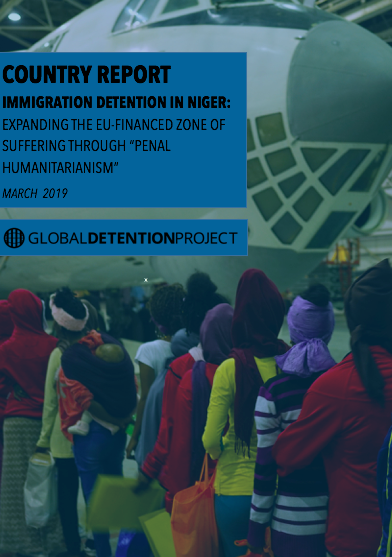Niger’s Covid-19 situation has been directly impacted by measures taken in neighbouring countries, including in particular Libya, whose push backs of migrants into Niger has forced the country to set up quarantines. As of 31 March, 34 people had tested positive for Covid-19 in Niger. The government has taken certain measures to avoid the spread […]
Last updated: March 2019
DETENTION STATISTICS
DETAINEE DATA
ALTERNATIVES TO DETENTION
ADDITIONAL ENFORCEMENT DATA
PRISON DATA
POPULATION DATA
SOCIO-ECONOMIC DATA & POLLS
LEGAL & REGULATORY FRAMEWORK
Does the Country Have Specific Laws that Provide for Migration-Related Detention?
Detention-Related Legislation
GROUNDS FOR DETENTION
Criminal Penalties for Immigration-Related Violations
Grounds for Criminal Immigration-Related Incarceration / Maximum Length of Incarceration
LENGTH OF DETENTION
DETENTION INSTITUTIONS
PROCEDURAL STANDARDS & SAFEGUARDS
COSTS & OUTSOURCING
Description of Foreign Assistance
From the EU Emergency Trust Fund for Africa: 6 million EUR for the establishment of a joint investigation team to combat irregular migration, human trafficking, and people smuggling
From the EU Emergency Trust Fund for Africa: 30 million EUR to support Niger in its fight against organised crime, smuggling, and human trafficking (AJUSEN)
From the EU Emergency Trust Fund for Africa: 7 million EUR for the response mechanism and resources for migrants (MRRM)
COVID-19 DATA
TRANSPARENCY
MONITORING
NATIONAL HUMAN RIGHTS MONITORING BODIES
NATIONAL PREVENTIVE MECHANISMS (OPTIONAL PROTOCOL TO UN CONVENTION AGAINST TORTURE)
NON-GOVERNMENTAL ORGANISATIONS (NGOS)
GOVERNMENTAL MONITORING BODIES
INTERNATIONAL DETENTION MONITORING
INTERNATIONAL TREATIES & TREATY BODIES
International Treaties Ratified
Ratio of relevant international treaties ratified
Individual Complaints Procedures
Relevant Recommendations or Observations Issued by Treaty Bodies
Global Detention Project and Partner Submissions to Treaty Bodies
> UN Special Procedures
Relevant Recommendations or Observations by UN Special Procedures
> UN Universal Periodic Review
Global Detention Project and Partner Submissions to Universal Periodic Review
HEALTH CARE PROVISION
HEALTH IMPACTS
COVID-19
Country Updates
Government Agencies
Ministère de la Justice - https://www.gouv.ne
International Organisations
UNHCR - https://www.unhcr.org/where-we-work/countries/niger
IOM - https://niger.iom.int/
ILO - https://www.ilo.org/regions-and-countries/africa/niger
NGO & Research Institutions
Caritas - https://www.caritas.org/where-caritas-work/africa/niger/
Catholic Relief Service - https://www.crs.org/where-we-work/africa/niger


![Migrants receive assistance in Madama, a military outpost close to the border between Niger and Libya [Courtesy: IOM Niger]](https://globaldetentionproject.org:3000/api/gdpUploadFiles/sources/download/Madama-military-outpost-Niger-Libya.jpeg)

